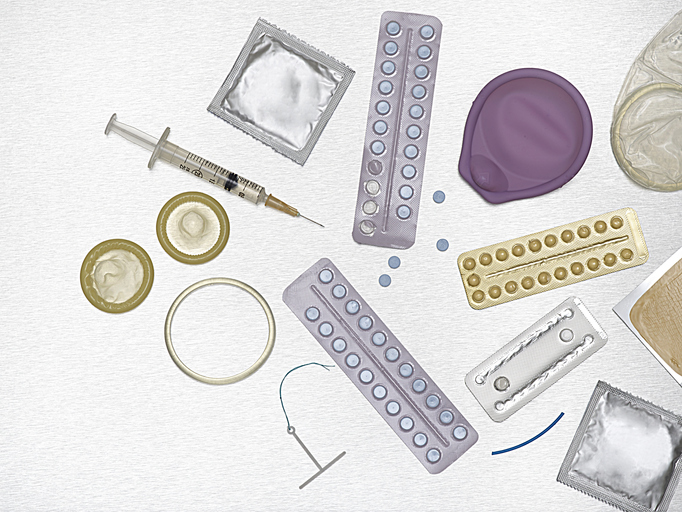A Guide To Different Types Of Birth Control
A Guide To The Different Types Of Birth Control + Choosing The Best One For You
Share the post
Share this link via
Or copy link

Source: SCIENCE PHOTO LIBRARY / Getty
With the Supreme Court recently overthrowing Roe V. Wade, understanding your options when it comes to pregnancy prevention is more important than ever. Depending on who you ask, some people might tell you there are anywhere from 11 to 22 types of birth control. Much of the discrepancy boils down to whether or not you count non-medical forms like the pull-out method, fertility tracking and abstinence. But if you’re looking at just the types of birth control that you’d get from a pharmacy or doctor, there is still a lot to choose from, and it’s far from one type suits all.
You have the power to choose. Here is a guide to help you choose the best birth control for you.
Hormonal Vs Non-Hormonal Birth Control

Source: Mindful Media / Getty
Hormonal birth control methods will contain either progestin, progesterone, estrogen or a combination of these. Most forms work by preventing or reducing ovulation. They can also prevent pregnancy by thickening cervical mucus and stopping sperm from getting into the uterus. Additionally, they can thin the lining of your uterus, minimizing the chances that an egg can attach.
Love MadameNoire? Get more! Join the MadameNoire Newsletter
We care about your data. See our privacy policy.
Hormonal birth control methods are some of the most effective forms of birth control. Most see an effectiveness rate of 99 percent with perfect use around 94 percent with typical use in preventing pregnancy. Effectiveness rates drop significantly for non-hormonal forms. However, some women don’t want to take hormonal birth control because it can have side effects including:
- Weight gain
- Mood swings
- Irregular periods
- Nausea
- Acne
- Headaches
- Low libido
Alternatively, some women take hormonal birth control specifically because it helps manage many of the symptoms listed above – specifically irregular periods, mood swings and acne.
MADAMENOIRE breaks down each type of birth control, as well as cost. These costs have been sourced from Planned Parenthood.
The Different Types Of Birth Control

Source: SCIENCE PHOTO LIBRARY / Getty
Hormonal
The Shot
Best For: The Forgetful
What you might pay: Depending on insurance, $0 and up to $150 per shot
Remembering to take a birth control pill every single day, let alone pack your pills, isn’t for everyone. And if you rely on condoms, you’ll have to make sure you have those stashed away in the appropriate places. If you worry you won’t remember these methods, then the shot could be for you.
The depo provera shot involves an injection that you’ll receive from your doctor, every three months. So all you have to do is remember to make that appointment every 90 days. The shot itself contains the hormone progestin, which stops ovulation from taking place.
It can be 99 percent effective when taken properly. Most see effectiveness of 94 percent.
The Birth Control Pill
Best for: The Skittish
What you might pay: Depending on insurance, $0 to $50 per month
On this list, we’ll go over shots, surgically implanted items, surgeries and more invasive options. But for those who don’t like needles, stirrups or anything that feels invasive, the pill is a great, simple option. You probably already take other medications, as well as supplements, so swallowing a tiny pill will feel natural.
There are three types of pills: the combination pill, the progestin-only pill and the continuous use pill.
The combination pill contains estrogen and progestin. It prevents pregnancy in two ways: first, it stops ovulation. Then, it thickens the fluid around your cervix, making it more difficult for sperm to make it to the uterus.
Progestin-only pills primarily prevent pregnancy by thickening the fluid around the cervix, as well as thinning the lining of the uterus. This makes it difficult for sperm to reach the uterus, and for an egg to implant. Some progestin-only pills also stop ovulation.
Continuous use pills are those you take for anywhere from 12 to 84 days without a break, according to Mayo Clinic. With the combination and progestin-only pills, you take active pills for three weeks, and then one week of placebo pills.But with continuous use pills, you will not take placebo pills for an extended period of time. This means you skip your period for a while which, for some women with certain conditions like painful periods, can be a benefit.
These pills can offer 99 percent effectiveness with perfect use and between 91 to 93 percent with typical use.
The Patch
Best for: The Forgetful + Needle-Averse
What you might pay: Depending on insurance, $0 to $150 per month
Some women worry they won’t remember to take the pill every day, but also have a fear of needles. The transdermal patch can be a great option. You will need to replace your patch once a week.
The patch is placed on your butt, back or arm. It releases estrogen and progestin – the same hormones found in the pill – into your body, stopping ovulation. Much like with the combination and progestin-only pills, there is a one week break from hormones. You apply a new patch every week, for three weeks, then do one patch-free week, and restart the cycle.
With perfect use it can be 99 percent effective and with typical use is 91 percent effective.
The Ring
Best for: The Discreet
What you might pay: Depending on insurance, $0 to $200 per month
The vaginal ring is a two-inch-wide plastic ring that you place inside of yourself. It releases estrogen and progesterone and stops ovulation. You leave each ring in for three weeks, remove it for a one-week break, and then put in a new one.
The ring is 99 percent effective with perfect use and 91 percent effective with typical use.
Hormonal IUD
Best for Prolonged Prevention
What you might pay: Depending on insurance, $0 to $1,300 every three to eight years depending on the brand.
The hormonal IUD is good for people who don’t want to birth for several years – three to eight to be exact. This is a small device that your doctor implants in your uterus. It releases progestin, stopping ovulation, and can remain there for several years at a time.
The hormonal IUD is one of the most effective forms of birth control, at over 99 percent effective.
Non-Hormonal

Source: BSIP/UIG / Getty
Copper IUD
Best for: Natural Long-Term Planners
What you might pay: Depending on insurance, $0 to $1,300
Those who like the apply-it-and-forget-it nature of the hormonal IUD but who want non-hormonal birth control can consider the copper IUD. This IUD releases copper ions into the uterus, creating an inhospitable environment for sperm. Plus, some forms of this IUD can be left in for up to 10 years.
The copper IUD is over 99 percent effective at preventing pregnancy.
Condoms
Best for: Cost Conscious
What you’ll pay: Roughly $1 each or $2 to $6 per box
External condoms – the most commonly used type of condoms – are the most effective in protecting against sexually transmitted infections. They’re also easy to use and easy to pack.
External condoms are 95 percent effective with perfect use and 86 percent effective with typical use.
Internal condoms
Best for: Cost effective
What you might pay: Roughly $2 to $3 each
With these, you wear the condom. These are polyurethane pouches that line the vaginal canal. Put them in right before sex and take them out right after.
Internal condoms are 95 percent effective with perfect use and 79 percent effective with typical use.
The Sponge Or Diaphragm
Best for: Uninterrupted Sensation
What you might pay: Around $15 per sponge. Depending on insurance, $0 to $250 for a diaphragm
Those looking for a non-hormonal form of birth control that doesn’t interfere with the sensation of sex like internal and external condoms can look into sponges and diaphragms. However, note that these do not protect against STIs.
Both a diaphragm and a sponge act as small, spermicide-saturated discs that sit over the cervix and kill sperm that tries to get inside the uterus. The main difference is that sponges are one-time-use, and come pre-saturated in spermicide. Diaphragms are prescription-only but can be used repeatedly. You need to apply spermicide yourself with each use. One perk of the sponge and diaphragm is that you can leave it in for 24 hours, so you don’t need to replace it with each round of sex within that window.
If you get a diaphragm, your doctor should check it once a year to make sure it still fits correctly. You will usually get a new one every two years.
The sponge is 91 percent effective with perfect use and 80 percent effective with typical use. It is not recommended for those who have given birth, as the effectiveness rate drops. The diaphragm is 96 percent effective with perfect use and 88 percent effective with typical use.
RELATED CONTENT: Male Birth Control Studies To Begin This Year
-

Style, Swagger, And Star Power: Rihanna, Ciara, Olandria, Angel Reese And More Shine At The 2025 CFDA Fashion Awards
-

From Slammer To Glamour: Watch 'Real Housewives Of Potomac' Star Karen Huger Freed Early From Jail In Full Makeup Beat
-

How Fit Women Eat In Group Settings
-

Mompreneurs: iOne SVP Allison McGevna Talks Breaking Revenue Records And Scheduling Time For Creativity



